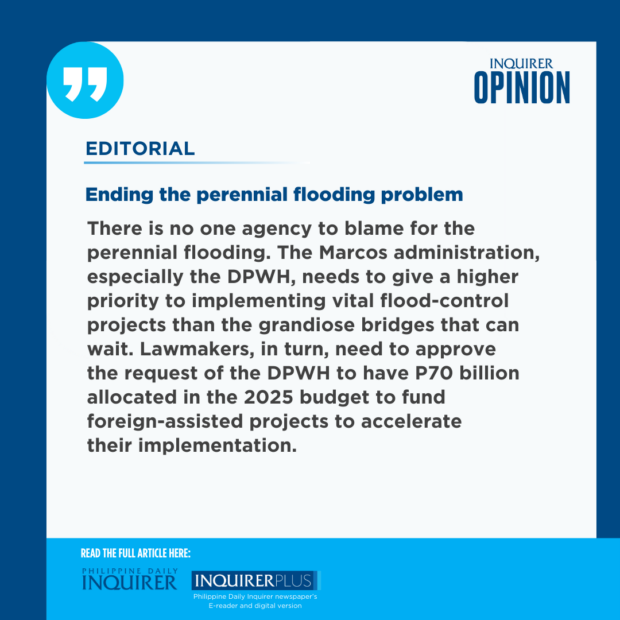Ending the perennial flooding problem

Every time the rainy season sets in, a favorite topic of discussion — and blame-passing— is the flooding that comes with it. Such is the case, without fail, since as far back as one can remember. For 2024, it began after President Marcos, in his third State of the Nation Address (Sona) last July, bragged that more than 5,500 flood-control projects have already been completed under his administration. Two days later, massive rains brought by Supertyphoon Carina and the southwest monsoon inundated many parts of the country.
This triggered a congressional investigation with one significant revelation. Despite the government spending P1.2 trillion on flood control projects since 2009, the country still lacks an integrated master plan.
This much was admitted by Secretary Manuel Bonoan of the Department of Public Works and Highways (DPWH) during a Senate committee on public works hearing early last month, noting that “several master plans” exist in 18 major river basins, which are in various preparation stages.
Appearing at the House days later to again explain why flooding continues, the DPWH made another revelation. Bonoan noted that the 5,500 completed projects that the President reported in his third Sona were just small band-aid solutions.
P351-billion ‘master plan’
“These are immediate projects and engineering interventions all over the country that are not part of the master plan. These are stand-alone projects to provide immediate relief and protection to low-lying areas,” he said.
There is actually a flood-control master plan, at least for Metro Manila and nearby areas. Shortly after the Carina flooding but before the congressional probe, the President called to Malacañang the officials of the DPWH, the Metropolitan Manila Development Authority (MMDA), and the Department of the Interior and Local Government (DILG).
In that meeting, Bonoan stated that there is a P351-billion “master plan” approved during the administration of President Benigno Aquino III in 2012 that the government is implementing.
Apart from the Marikina Dam and the Parañaque spillway, the plan also includes the Manggahan Control Gate Structure, which aims to impound floodwaters from the Sierra Madre in Laguna Lake to prevent them from going to Metro Manila.
The problem, Bonoan admitted, is that despite being approved more than a decade ago, the master plan is only 30 percent complete.
Counterpart funding
Part of the delay in its implementation can be traced to lawmakers. Big-ticket flood-control projects funded by foreign agencies such as the World Bank have conditions, one being the need for the government to chip in what is called counterpart funding for the loans to be released.
Two examples cited by Marikina Rep. Stella Quimbo, senior vice chair of the appropriations committee, during one of the hearings as characterized by “negative slippages, low fund use, and major delays” are the Pasig-Marikina River Channel Improvement Project and the first phase of the Metro Manila Flood Management Project, both under the DPWH.
Bonoan explained that part of the delay was that budgetary allocations for these projects were “drastically reduced against our national expenditure program proposals,” referring to Congress’ failure to approve budget for foreign-assisted projects in 2024 despite the DPWH’s request for P70 billion.
Lawmakers cannot wash their hands of the problem because allocations for these foreign-assisted projects were reportedly among those realigned to their pet projects.
The Commission on Audit must also thoroughly scrutinize these flood-control projects for fund misuse and corruption, which is rampant in public works and infrastructure projects, to ensure that billions in taxpayer money do not go down the drain.
Grandiose bridges
Ordinary households also contribute to the problem as noted by Mr. Marcos when he made an ocular inspection of areas in Metro Manila affected by Carina.
“I hope people will learn. Don’t throw trash because that trash is what blocked our [floodwater pumping stations], so they’re not as effective as they could be,” he said in Filipino.
Bonoan said that 70 percent of Metro Manila’s drainage system is silted with garbage. Addressing this problem falls squarely on the DILG. Local government units, specifically the barangay, must ensure that residents living near or along “esteros” dispose of their garbage properly and that bridges and other public structures are cleared of obstructions.
There is no one agency to blame for the perennial flooding. The Marcos administration, especially the DPWH, needs to give a higher priority to implementing vital flood-control projects than the grandiose bridges that can wait. Lawmakers, in turn, need to approve the request of the DPWH to have P70 billion allocated in the 2025 budget to fund foreign-assisted projects to accelerate their implementation.
All of these components need to be done at the same time. Otherwise, the perennial flooding and annual ritual of blame-passing each time the rainy season comes will never end.




















